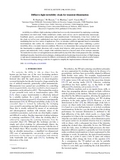Mostrar el registro sencillo del ítem
Diffusive-light invisibility cloak for transient illumination
| dc.creator | Orazbayev, Bakhtiyar | es_ES |
| dc.creator | Beruete Díaz, Miguel | es_ES |
| dc.creator | Martínez, Alejandro | es_ES |
| dc.creator | García Meca, Carlos | es_ES |
| dc.date.accessioned | 2016-12-23T13:55:05Z | |
| dc.date.available | 2016-12-23T13:55:05Z | |
| dc.date.issued | 2016 | |
| dc.identifier.issn | 2469-9926 (Print) | |
| dc.identifier.issn | 2469-9934 (Electronic) | |
| dc.identifier.uri | https://hdl.handle.net/2454/23128 | |
| dc.description.abstract | Invisibility in a diffusive-light-scattering medium has been recently demonstrated by employing a scattering-cancellation core-shell cloak. Unlike nondiffusive cloaks, such a device can be simultaneously macroscopic, broadband, passive, polarization independent, and omnidirectional. Unfortunately, it has been verified that this cloak, as well as more sophisticated ones based on transformation optics, fail under pulsed illumination, invalidating their use for a variety of applications. Here, we introduce a different approach based on unimodular transformations that enables the construction of unidirectional diffusive-light cloaks exhibiting a perfect invisibility effect, even under transient conditions. Moreover, we demonstrate that a polygonal cloak can extend this functionality to multiple directions with a nearly ideal behavior, while preserving all other features. We propose and numerically verify a simple cloak realization based on a layered stack of two isotropic materials. The studied devices have several applications not addressable by any of the other cloaks proposed to date, including shielding from pulse-based detection techniques, cloaking undesired scattering elements in time-of-flight imaging or high-speed communication systems for diffusive environments, and building extreme optical security features. The discussed cloaking strategy could also be applied to simplify the implementation of thermal cloaks. | en |
| dc.description.sponsorship | This work was supported in part by the Spanish Ministerio de Economía y Competitividad under contracts No. TEC2014- 51902-C2-1-R and No. TEC2014- 51902-C2-2-R. B.O. is sponsored by the Spanish Ministerio de Economía y Competitividad under Grant No. FPI BES-2012-054909. M.B. is sponsored by the Spanish Ministerio de Economía y Competitividad via Grant No. RYC-2011-08221. C.G.-M. acknowledges support from Generalitat Valenciana through the VALi+d postdoctoral program (Grant No. APOSTD/2014/044). | en |
| dc.format.mimetype | application/pdf | en |
| dc.language.iso | eng | en |
| dc.publisher | American Physical Society | en |
| dc.relation.ispartof | Physical Review A, 94, 063850 (2016) | en |
| dc.rights | © 2016 American Physical Society | en |
| dc.subject | Diffusive-light invisibility cloak | en |
| dc.subject | Transient illumination | en |
| dc.title | Diffusive-light invisibility cloak for transient illumination | en |
| dc.type | Artículo / Artikulua | es |
| dc.type | info:eu-repo/semantics/article | en |
| dc.contributor.department | Ingeniería Eléctrica y Electrónica | es_ES |
| dc.contributor.department | Ingeniaritza Elektrikoa eta Elektronikoa | eu |
| dc.rights.accessRights | Acceso abierto / Sarbide irekia | es |
| dc.rights.accessRights | info:eu-repo/semantics/openAccess | en |
| dc.identifier.doi | 10.1103/PhysRevA.94.063850 | |
| dc.relation.projectID | info:eu-repo/grantAgreement/MINECO//TEC2014-51902-C2-2-R/ES/ | en |
| dc.relation.projectID | info:eu-repo/grantAgreement/MICINN//TEC2011-28664-C02-01/ES/ | en |
| dc.relation.publisherversion | https://doi.org/10.1103/PhysRevA.94.063850 | |
| dc.type.version | Versión publicada / Argitaratu den bertsioa | es |
| dc.type.version | info:eu-repo/semantics/publishedVersion | en |


